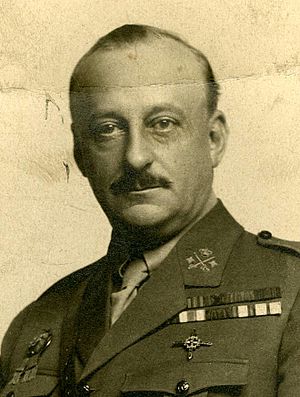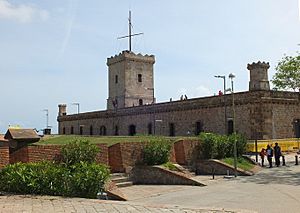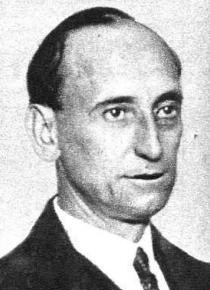Fermín Galán facts for kids
Quick facts for kids
Fermín Galán Rodríguez
|
|
|---|---|
| Born | 4 October 1899 San Fernando, Cádiz, Spain
|
| Died | 14 December 1930 (aged 31) Huesca, Spain
|
| Nationality | Spanish |
| Occupation | Soldier |
| Known for | Leader of the Jaca uprising |
Fermín Galán Rodríguez (born October 4, 1899 – died December 14, 1930) was a Spanish soldier. He is remembered for leading an important event called the Jaca uprising. This happened just a few months before Spain became a republic, which means a country ruled by elected officials instead of a king.
Fermín Galán came from a humble background, even though his father was in the Navy. When he was 10, his father passed away. Soon after, he went to a special boarding school for children whose parents were soldiers. This school helped him prepare for a military career. In 1918, he became a lieutenant. He served in Morocco, where he learned Arabic and became known as an expert on African matters. He was later promoted to Captain.
In 1925, while recovering from an injury, Galán started thinking about how to overthrow the government. Spain was then under a dictatorship led by General Miguel Primo de Rivera. Galán wanted to create a republic instead. The next year, he helped plan a secret uprising. This plan was discovered, and he was sent to prison for three and a half years. He was released in January 1930.
After his release, Galán was sent to a quiet town called Jaca in northern Aragon. There, he began planning another uprising. This time, he wanted it to happen with strikes and protests from regular citizens. The revolt started too early on December 12, 1930. It was not well-organized and was quickly stopped. Galán was put on trial very quickly and executed on December 14, 1930. However, his actions helped spark bigger changes. A few months later, the Second Spanish Republic was formed.
Contents
Early Life and School Years (1899–1915)
Fermín Galán Rodríguez was born in San Fernando, Cádiz, Spain, on October 4, 1899. He was the third of five children in his family. His father, Juan Galán Mateo, came from a family of poor farmers. He had joined the Navy as a Constable. Fermín's mother was the oldest of three daughters of a baker from San Fernando.
Fermín Galán grew up in a family that believed in republican ideas. They were also not very strict about their Catholic faith. His father was often away at sea for long trips. He died in the spring of 1909 when Fermín was 10 years old.
After his father's death, his mother moved to Madrid. She worked as a seamstress to support her family. When Fermín was 11, she enrolled him in a special boarding school. This school was for children whose parents had died in war. His younger brothers also joined the school when they were old enough. The school focused on discipline and sports, especially gymnastics. It prepared students to join military academies. Both of Fermín's brothers also became soldiers. Francisco Galán became a colonel, and José María Galán commanded army groups.
Becoming a Soldier (1915–1925)

In 1915, at age 15, Fermín Galán joined the Toledo Infantry Academy. This was a rare path for someone from a farming or working-class family. At 18, he became a second lieutenant. He joined an infantry regiment in Vitoria.
He didn't like the low level of education in his regiment. He also disliked how they were used to stop workers' protests. So, he asked to be transferred. He moved to a regiment in Tétouan, Morocco. Spain was fighting the Riffians there since 1912. During his year and a half there, Galán read many books about society. He learned about the Russian Revolution and how it helped workers and farmers.
In 1921, he joined the Indigenous Police in Ceuta. He stayed there for two years and learned Arabic. He was promoted to lieutenant. Galán wrote a plan to end the war in Morocco. His commanders did not accept it. However, they saw his talent. In October 1922, they gave him a military award. They would often ask for his opinions.
In 1923, he was in Madrid. He presented his plan to a group called the Africanist League. The King listened to his ideas. But then, General Miguel Primo de Rivera took control of the government. This ended Galán's project. Galán was sent to a new post in the Jalifianos Service. He was known as an expert on Africa. He wrote articles and spoke for officers who had served in Africa. In April 1924, he joined the Foreign Legion. He was often praised for his bravery.
Galán was badly injured in a battle. He was sent to a military hospital in Madrid. While recovering, he became unhappy with Primo de Rivera's dictatorship. He started to think about secretly working to bring back the Republic. During this time, he wrote a book called La barbarie organizada (Organized Barbarism). It was about the war in Morocco. In April 1925, he was released from the hospital. After a short time in Ceuta and Madrid, he was promoted to captain. He joined an infantry regiment in Tarragona on August 13, 1925, when he was 25.
Planning a Revolution (1925–1930)
As a member of the group planning to end the dictatorship, Fermín Galán often visited Madrid. They planned an uprising for June 24, 1926. Galán asked for three days off from work. However, this plot, known as the "Sanjuanada", was discovered. On June 23, 1926, many people involved were arrested. The main leaders were only fined. Some generals received light sentences or were found not guilty. But Captain Galán and other officers were sentenced to six years in prison in Barcelona.

While in prison, first in Madrid and then in Montjuïc Castle, Galán stayed in touch with the group against the dictator and the king. He began to think about a movement that would involve both soldiers and regular citizens. He also connected with some union leaders in Catalonia. On December 21, 1926, he joined the Freemasons.
General Primo de Rivera was replaced by General Berenguer in January 1930. Berenguer gave a pardon to those involved in the "Sanjuanada" plot. Galán was released. He first lived in Barcelona. There, he worked with workers' groups and wrote for socialist newspapers. He published an essay called Escribe Nueva Creación. In it, he suggested a federal republic for Spain. He also proposed that communities should manage their own wealth. He believed Spain should be part of a "United States of Europe."
In June 1930, Galán was sent to Jaca. This was a remote place where the authorities hoped he would not cause trouble. But he still wanted to connect a military uprising with political movements against the dictatorship. He made contact with workers' unions in Zaragoza and Huesca. He became good friends with Ramón Acín, a union leader from Huesca.
In October 1930, the National Revolutionary Committee (CRN) was formed. Galán went to Madrid to meet its leaders. He was made the CRN's representative in Aragon. From then on, he pushed the CRN to support a national military uprising combined with public protests. But he was frustrated because the date for the uprising kept being postponed.

Galán called the CRN politicians "telephoners" because they seemed to talk a lot but not act. They finally agreed on December 12, 1930, for the uprising. But then the CRN postponed it to December 15. The CRN representative, Santiago Casares Quiroga, knew about the delay. He arrived in Jaca late on the night of December 11–12. But he did not tell Galán. Casares thought Galán already knew. He believed they could discuss the new plans the next day. Quiroga and his companion, Graco Marsá, stayed at a different hotel than Galán. Marsá thought they should contact Galán right away. But Quiroga said he was tired and needed to sleep first.
The Jaca Uprising (1930)
Fermín Galán started the uprising in Jaca in the early hours of December 12. Most of the soldiers in Jaca accepted him as their leader. They were ready to follow him anywhere. At least sixty officers and non-commissioned officers in Jaca supported him. That night, several officers met in Galán's hotel room. They finalized the details of their plan.
At 5:00 AM, the officers called out the troops. They arrested the military governor. They killed two police officers and a Civil Guard sergeant who resisted them. They took control of the telephone exchange, post office, and railway station. At 11:00 AM, they declared the Republic at the Town Hall.
Two groups of soldiers were formed to travel to Huesca. One group, led by Galán, would go by road. The other, led by Salvador Sediles, would go by train. There were delays in getting transport. So, they didn't leave Jaca until 3:00 PM. Around 5:00 PM, General Manuel de las Heras and some civil guards met Galán's group. He tried to stop the 500 men by force. Some shots were fired before the group continued its slow advance. When they reached Ayerbe, the rebels took control of the telephone and telegraph stations. They disarmed the civil guard and declared the Republic there too.
The group of 300 soldiers led by Sediles joined Galán's group in Ayerbe. The combined force then moved towards Huesca. At dawn on December 13, 1930, about 3 kilometers from Huesca, the rebels faced the government forces. Galán had to choose between fighting or talking. He thought many of the opposing soldiers were led by officers who supported the uprising. So, he chose to talk.
Captain Ángel García Hernández and Captain Salinas drove across the line in a car with a white flag. When they arrived and said they wanted to talk to the officers, they were immediately arrested. The government troops then started firing at the rebels. Galán refused to order his men to fight back. He said, "brothers cannot fight each other." He ordered a retreat. The rebel force broke apart. Galán surrendered willingly in Biscarrués with other rebels. He arrived in Ayerbe around 10:00 PM on December 13.
Legacy and Impact
On December 14, Captains Galán and García Hernández were quickly put on trial by a military court. They were sentenced to death. Other officers received life imprisonment. At his trial, Galán was asked if he had any partners in crime. He bravely replied that he did, and they were the "cowards who were trying him."
Galán and García Hernández were shot in a courtyard in Huesca at 3:00 PM on December 14, 1930. They chose to face the firing squad without blindfolds. Galán waved to the executioners and said "Until Never!" just before they fired. Their execution caused great anger against the government. The poet Rafael Alberti later wrote about how their deaths affected Spain. He said that the sound of the bullets was still heard across Spain in early 1931.
Galán and García Hernández became heroes of the Second Spanish Republic. This new government was formed on April 4, 1931. Their pictures were displayed in town halls and in the homes of workers all over Spain. Rafael Alberti wrote a poem and a play about the two heroes in 1931. Galán's own play, Berta, was also performed successfully in Madrid in April 1932. A film was made about Galán. In the film, a woman representing the Republic covered his body with a Republican flag.
Images for kids
-
Miguel Primo de Rivera. Fermín Galán wanted to end his government.
-
Montjuïc Castle, Barcelona. Galán was held here for three and a half years.
-
Santiago Casares Quiroga did not tell Galán in time about the delay in the uprising date.
Sources
See also
 In Spanish: Fermín Galán para niños
In Spanish: Fermín Galán para niños




